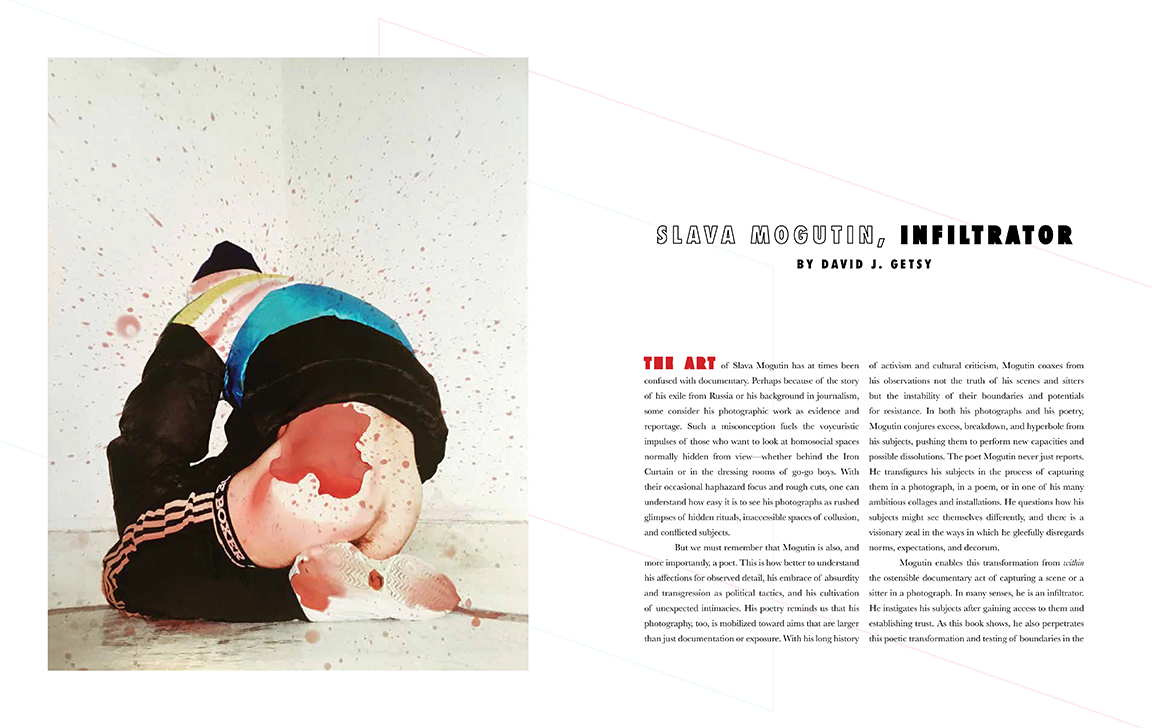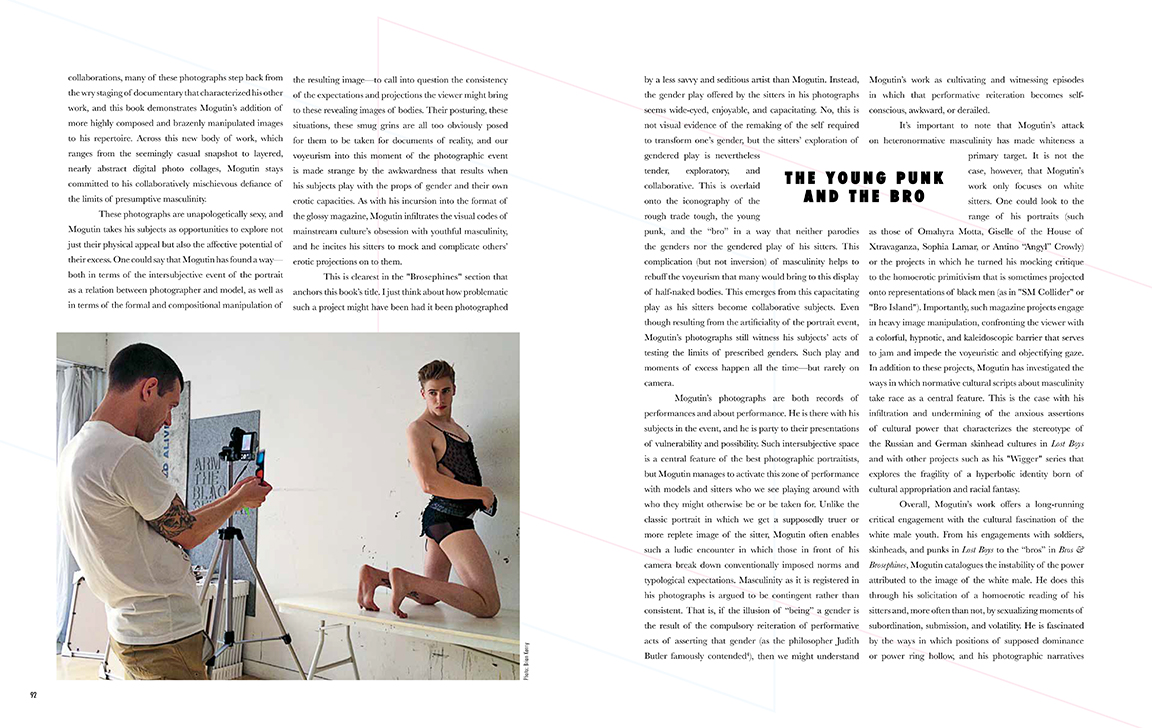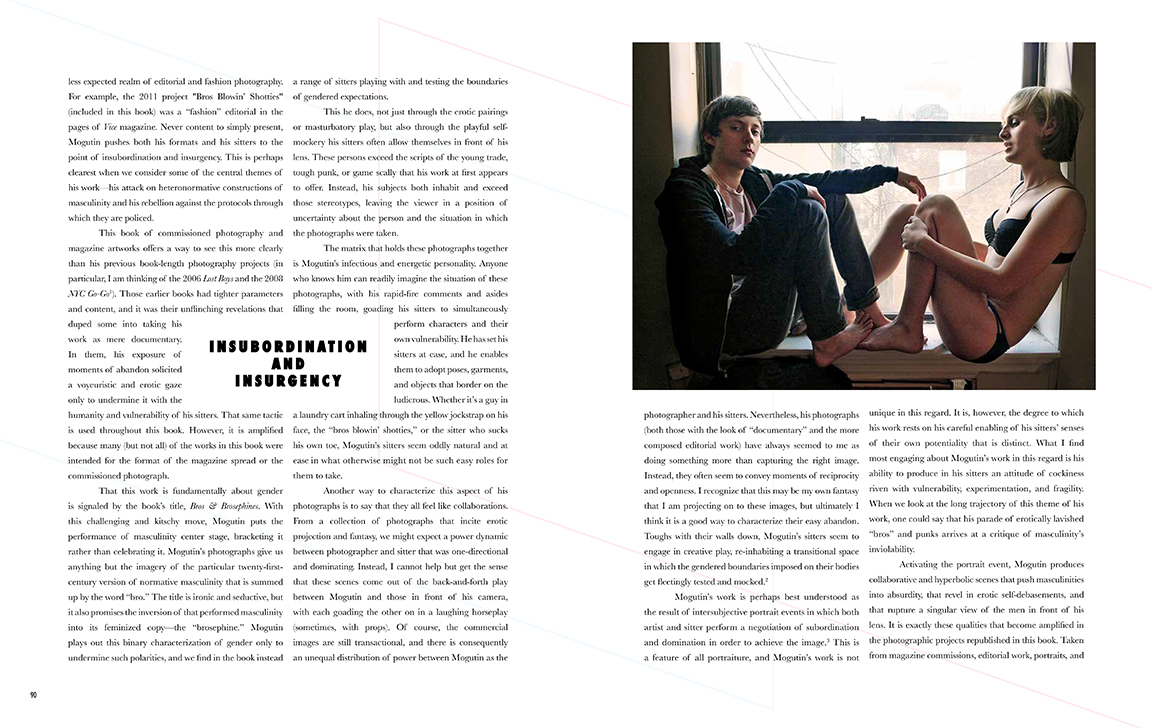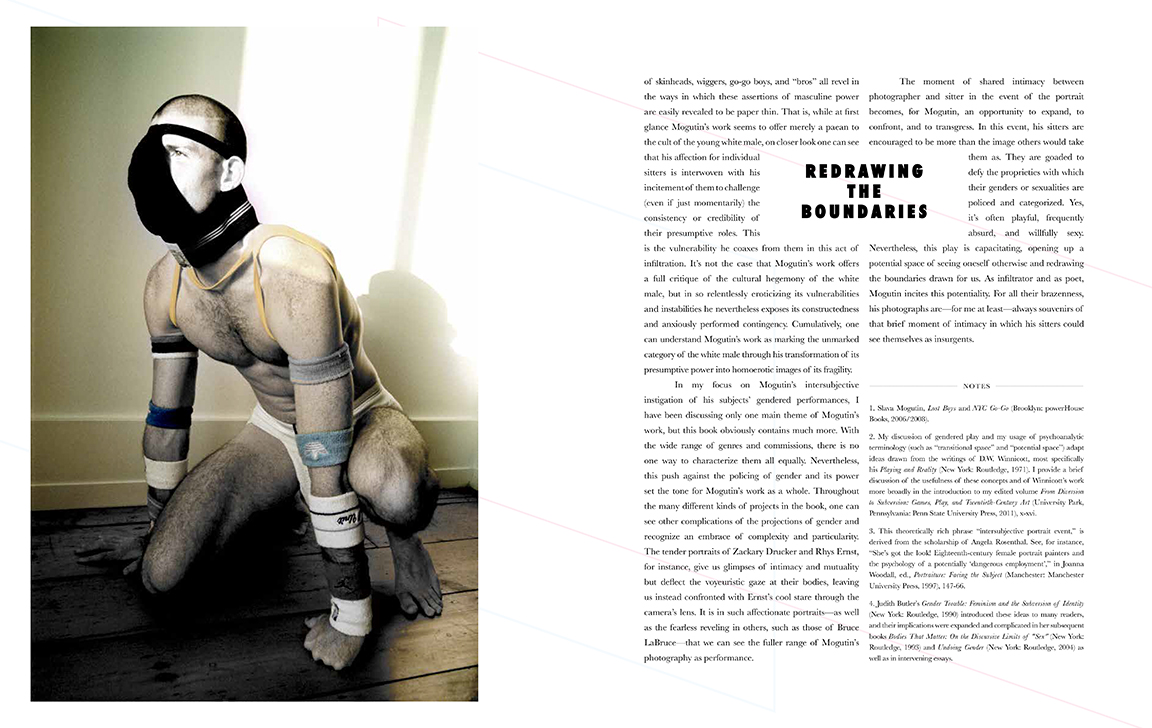Essay for Bros & Brosephines (powerHouse Books, Brooklyn, 2017)
The art of Slava Mogutin has at times been confused with documentary. Perhaps because of the story of his exile from Russia or his background in journalism, some consider his photographic work as evidence and reportage. Such a misconception fuels the voyeuristic impulses of those who want to look at homosocial spaces normally hidden from view — whether behind the Iron Curtain or in the dressing rooms of go-go boys. With their occasional haphazard focus and rough cuts, one can understand how easy it is to see his photographs as rushed glimpses of hidden rituals, inaccessible spaces of collusion, and conflicted subjects.
But we must remember that Mogutin is also, and more importantly, a poet. This is how better to understand his affections for observed detail, his embrace of absurdity and transgression as political tactics, and his cultivation of unexpected intimacies. His poetry reminds us that his photography, too, is mobilized toward aims that are larger than just documentation or exposure. With his long history of activism and cultural criticism, Mogutin coaxes from his observations not the truth of his scenes and sitters but the instability of their boundaries and potentials for resistance. In both his photographs and his poetry, Mogutin conjures excess, breakdown, and hyperbole from his subjects, pushing them to perform new capacities and possible dissolutions. The poet Mogutin never just reports. He transfigures his subjects in the process of capturing them in a photograph, in a poem, or in one of his many ambitious collages and installations. He questions how his subjects might see themselves differently, and there is a visionary zeal in the ways in which he gleefully disregards norms, expectations, and decorum.
Mogutin enables this transformation from within the ostensible documentary act of capturing a scene or a sitter in a photograph. In many senses, he is an infiltrator. He instigates his subjects after gaining access to them and establishing trust. As this book shows, he also perpetrates this poetic transformation and testing of boundaries in the less expected realm of editorial and fashion photography. For example, the 2011 project “Bros Blowin’ Shotties” (included in this book) was a “fashion” editorial in the pages of Vice magazine. Never content to simply present, Mogutin pushes both his formats and his sitters to the point of insubordination and insurgency. This is perhaps clearest when we consider some of the central themes of his work — his attack on heteronormative constructions of masculinity and his rebellion against the protocols through which they are policed.
This book of commissioned photography and magazine artworks offers a way to see this more clearly than his previous book-length photography projects (in particular, I am thinking of the 2006 Lost Boys and the 2008 NYC Go-Go[1]). Those earlier books had tighter parameters and content, and it was their unflinching revelations that duped some into taking his work as mere documentary. In them, his exposure of moments of abandon solicited a voyeuristic and erotic gaze only to undermine it with the humanity and vulnerability of his sitters. That same tactic is used throughout this book. However, it is amplified because many (but not all) of the works in this book were intended for the format of the magazine spread or the commissioned photograph.
That this work is fundamentally about gender is signaled by the book’s title — Bros and Brosephines. With this challenging and kitschy move, Mogutin puts the performance of masculinity center stage, bracketing it rather than celebrating it. Mogutin’s photographs give us anything but the imagery of the particular twenty-first-century version of normative masculinity that is summed up by the word “bro.” The title is ironic and seductive, but it also promises the inversion of that performed masculinity into its feminized copy — the “brosephine.” Mogutin plays out this binary characterization of gender only to undermine such polarities, and we find in the book instead a range of sitters playing with and testing the boundaries of gendered expectations.
This he does not just through the erotic pairings or masturbatory play, but also through the playful self-mockery his sitters often allow themselves in front of his lens. These persons exceed the scripts of the young trade, tough punk, or game scally that his work at first appears to offer. Instead, his subjects both inhabit and exceed those stereotypes, leaving the viewer in a position of uncertainty about the person and the situation in which the photographs were taken.
The matrix that holds these photographs together is Mogutin’s infectious and energetic personality. Anyone who knows him can readily imagine the situation of these photographs, with his rapid-fire comments and asides filling the room, goading his sitters to simultaneously perform characters and their own vulnerability. He has set his sitters at ease, and he enables them to adopt poses, garments, and objects that border on the ludicrous. Whether it’s a guy in a laundry cart inhaling through the yellow jockstrap on his face, the “bros blowin’ shotties”, or the sitter who sucks his own toe, Mogutin’s sitters seem oddly natural and at ease in what otherwise might not be so easy roles for them to take.
Another way to characterize this aspect of his photographs is to say that they all feel like collaborations. From such a collection of photographs that incite erotic projection and fantasy, we might expect a power dynamic between photographer and sitter that was one-directional and dominating. Instead, I cannot help get the sense that these scenes come out of the back-and-forth play between Mogutin and those in front of his camera, with each goading the other on in a laughing horseplay (sometimes, with props). Of course, the commercial images are still transactional, and there is consequently an unequal distribution of power between Mogutin as the photographer and his sitters. Nevertheless, his photographs (both those with the look of “documentary” and the more composed editorial work) have always seemed to me as doing something more than capturing the right image. Instead, they often seem to convey moments of reciprocity and openness. I recognize that this may be my own fantasy that I am projecting on to these images, but ultimately I think it is a good way to characterize their easy abandon. Toughs with their walls down, Mogutin’s sitters seem to engage in creative play, re-inhabiting a transitional space in which the gendered boundaries imposed on their bodies get fleetingly tested and mocked.[2]
Mogutin’s work is perhaps best understood as the result of intersubjective portrait events in which both artist and sitter perform a negotiation of subordination and domination in order to achieve the image.[3] This is a feature of all portraiture, and Mogutin’s work is not unique in this regard. It is, however, the degree to which his work rests on his careful enabling of his sitters’ senses of their own potentiality that is distinct. What I find most engaging about Mogutin’s work in this regard is his ability to produce in his sitters an attitude of cockiness riven with vulnerability, experimentation, and fragility. When we look at the long trajectory of this theme of his work, one could say that his parade of erotically lavished “bros” and punks arrives at a critique of masculinity’s inviolability.
Activating the portrait event, Mogutin produces collaborative and hyperbolic scenes that push masculinities into absurdity, that revel in erotic self-debasements, and that rupture a singular view of these men in front of his lens. It is exactly these qualities that become amplified in the photographic projects republished in this book. Taken from magazine commissions, editorial work, portraits, and collaborations, many of these photographs step back from the wry staging of documentary that characterized his other work, and this book demonstrates Mogutin’s addition of more highly composed and brazenly manipulated images to his repertoire. Across this new body of work, which ranges from the seemingly casual snapshot to layered, nearly abstract digital photo collages, Mogutin stays committed to his collaboratively mischievous defiance of the limits of presumptive masculinity.
These photographs are unapologetically sexy, and Mogutin takes his subjects as opportunities to explore not just their physical appeal but also the affective potential of their excess. One could say that Mogutin has found a way — both in terms of the intersubjective event of the portrait as a relation between photographer and model as well as in terms of the formal and compositional manipulation of the resulting image — to call into question the consistency of the expectations and projections the viewer might bring to these revealing images of bodies. Their posturing, these situations, these smug grins are all too obviously posed for them to be taken for documents of reality, and our voyeurism into this moment of the photographic event is made strange by the awkwardness that results when his subjects play with the props of gender and their own erotic capacities. As with his incursion into the format of the glossy magazine, Mogutin infiltrates the visual codes of mainstream culture’s obsession with youthful masculinity, and he incites his sitters to mock and complicate others’ erotic projections on to them.
This is clearest in the “Brosephines” section that anchors this book’s title. I just think about how problematic such a project might have been had it been photographed by a less savvy and seditious artist than Mogutin. Instead, the gender play offered by the sitters in his photographs seems wide-eyed, enjoyable, and capacitating. No, this is not visual evidence of the remaking of the self required to transform one’s gender, but the sitters’ exploration of gendered play is nevertheless tender, exploratory, and collaborative. This is overlaid onto the iconography of the rough trade tough, the young punk, and the “bro” in a way that neither parodies the genders nor the gendered play of his sitters. This complication (but not inversion) of masculinity helps to rebuff the voyeurism that many would bring to this display of half-naked bodies. This emerges from this capacitating play as his sitters become collaborative subjects. Even though resulting from the artificiality of the portrait event, Mogutin’s photographs still witness his subjects’ acts of testing the limits of prescribed genders. Such play and moments of excess happen all the time — but rarely on camera.
Mogutin’s photographs are both records of performances and about performance. He is there with his subjects in the event, and he is party to their presentations of vulnerability and possibility. Such intersubjective space is a central feature of the best photographic portraitists, but Mogutin manages to activate this zone of performance with models and sitters who we see playing around with who they might otherwise be or be taken for. Unlike the classic portrait in which we get a supposedly truer or more replete image of the sitter, Mogutin often enables such a ludic encounter in which those in front of his camera break down conventionally imposed norms and typological expectations. Masculinity as it is registered in his photographs is argued to be contingent rather than consistent. That is, if the illusion of “being” a gender is the result of the compulsory reiteration of performative acts of asserting that gender (as the philosopher Judith Butler famously contended[4]), then we might understand Mogutin’s work as cultivating and witnessing episodes in which that performative reiteration becomes self-conscious, awkward, or derailed.
It’s important to note that Mogutin’s attack on heteronormative masculinity has made whiteness a primary target. It is not the case, however, that Mogutin’s work only focuses on white sitters. One could look to the range of his portraits (such as those of Omahyra Motta, Giselle of the House of Extravaganza, Sophia Lamar, or Antino “Angyl” Crowly) or the projects in which he turned his mocking critique to the homoerotic primitivism that is sometimes projected onto representations of black men (as in “SM Collider” or “Bro Island”). Importantly, such magazine projects engage in heavy image manipulation, confronting the viewer with a colorful, hypnotic, and kaleidoscopic barrier that serves to jam and impede the voyeuristic and objectifying gaze. In addition to these projects, Mogutin has investigated the ways in which normative cultural scripts about masculinity take race as a central feature. This is the case with his infiltration and undermining of the anxious assertions of cultural power that characterizes the stereotype of the Russian and German skinhead cultures in Lost Boys and with other projects such as his “Wigger” series that explores the fragility of a hyperbolic identity born of cultural appropriation and racial fantasy.
Overall, Mogutin’s work offers a long-running critical engagement with the cultural fascination of the white male youth. From his engagements with soldiers, skinheads, and punks in Lost Boys to the “bros” in Bros & Brospehines, Mogutin catalogues the instability of the power attributed to the image of the white male. He does this through his solicitation of a homoerotic reading of his sitters and, more often than not, by sexualizing moments of subordination, submission, and volatility. He is fascinated by the ways in which positions of supposed dominance or power ring hollow, and his photographic narratives of skinheads, wiggers, go-go boys, and “bros” all revel in the ways in which these assertions of masculine power are easily revealed to be paper thin. That is, while at first glance Mogutin’s work seems to offer merely a paean to the cult of the young white male, on closer look one can see that his affection for individual sitters is interwoven with his incitement of them to challenge (even if just momentarily) the consistency or credibility of their presumptive roles. This is the vulnerability he coaxes from them in this act of infiltration. It’s not the case that Mogutin’s work offers a full critique of the cultural hegemony of the white male, but in so relentlessly eroticizing its vulnerabilities and instabilities he nevertheless exposes its constructedness and anxiously performed contingency. Cumulatively, one can understand Mogutin’s work as marking the unmarked category of the white male through his transformation of its presumptive power into homoerotic images of its fragility.
In my focus on Mogutin’s intersubjective instigation of his subjects’ gendered performances, I have been discussing only one main theme of Mogutin’s work, but this book obviously contains much more. With the wide range of genres and commissions, there is no one way to characterize them all equally. Nevertheless, this push against the policing of gender and its power set the tone for Mogutin’s work as a whole. Throughout the many different kinds of projects in the book, one can see other complications of the projections of gender and recognize an embrace of complexity and particularity. The tender portraits of Zackary Drucker and Rhys Ernst, for instance, give us glimpses of intimacy and mutuality but deflect the voyeuristic gaze at their bodies, leaving us instead confronted with Ernst’s cool stare through the camera’s lens. It is in such affectionate portraits — as well as the fearless reveling in others such as those of Bruce LaBruce — that we can see the fuller range of Mogutin’s photography as performance.
The moment of shared intimacy between photographer and sitter in the event of the portrait becomes, for Mogutin, an opportunity to expand, to confront, and to transgress. In this event, his sitters are encouraged to be more than the image others would take them as. They are goaded to defy the proprieties with which their genders or sexualities are policed and categorized. Yes, it’s often playful, frequently absurd, and willfully sexy. Nevertheless, this play is capacitating, opening up a potential space of seeing oneself otherwise and redrawing the boundaries drawn for us. As infiltrator and as poet, Mogutin incites this potentiality. For all their brazenness, his photographs are — for me at least — always souvenirs of that brief moment of intimacy in which his sitters could see themselves as insurgents.
[1] Slava Mogutin, Lost Boys (Brooklyn: powerHouse Books, 2006) and NYC Go-Go (Brooklyn: powerHouse Books, 2008).
[2] My discussion of gendered play and my usage of psychoanalytic terminology (such as “transitional space” and “potential space”) adapt ideas drawn from the writings of D.W. Winnicott, most specifically his Playing and Reality (New York: Routledge, 1971). I provide a brief discussion of the usefulness of these concepts and of Winnicott’s work more broadly in the introduction to my edited volume From Diversion to Subversion: Games, Play, and Twentieth-Century Art (University Park, Pennsylvania: Penn State University Press, 2011), x-xvi.
[3] This theoretically rich phrase “intersubjective portrait event,” is derived from the scholarship of Angela Rosenthal. See, for instance, “She’s got the look! Eighteenth-century female portrait painters and the psychology of a potentially ‘dangerous employment’,” in Joanna Woodall, ed., Portraiture: Facing the Subject (Manchester: Manchester University Press, 1997), 147-66.
[4] Judith Butler’s Gender Trouble: Feminism and the Subversion of Identity (New York: Routledge, 1990) introduced these ideas to many readers, and their implications were expanded and complicated in her subsequent books Bodies That Matter: On the Discursive Limits of ‘Sex’ (New York: Routledge, 1993) and Undoing Gender (New York: Routledge: 2004) as well as in intervening essays.
© David J. Getsy, 2017
David J. Getsy is the Goldabelle McComb Finn Distinguished Professor of Art History at the School of the Art Institute of Chicago. His books include Abstract Bodies: Sixties Sculpture in the Expanded Field of Gender (Yale University Press, 2015), Scott Burton: Collected Writings on Art and Performance, 1965–1975 (Soberscove Press, 2012), From Diversion to Subversion: Games, Play, and Twentieth-Century Art (Penn State University Press, 2011), Rodin: Sex and the Making of Modern Sculpture (Yale University Press, 2010), and most recently the anthology Queer for the Whitechapel Gallery’s “Documents of Contemporary Art” book series (MIT Press, 2016).



